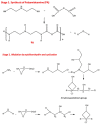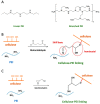Polymeric Wet-Strength Agents in the Paper Industry: An Overview of Mechanisms and Current Challenges
- PMID: 37298219
- PMCID: PMC10252473
- DOI: 10.3390/ijms24119268
Polymeric Wet-Strength Agents in the Paper Industry: An Overview of Mechanisms and Current Challenges
Abstract
Polymeric wet-strength agents are important additives used in the paper industry to improve the mechanical properties of paper products, especially when they come into contact with water. These agents play a crucial role in enhancing the durability, strength, and dimensional stability of paper products. The aim of this review is to provide an overview of the different types of wet-strength agents available and their mechanisms of action. We will also discuss the challenges associated with the use of wet-strength agents and the recent advances in the development of more sustainable and environmentally friendly agents. As the demand for more sustainable and durable paper products continues to grow, the use of wet-strength agents is expected to increase in the coming years.
Keywords: bio-based wet-strength agents; chitosan; paper packaging; polyamideamine-epichlorydrin resin.
Conflict of interest statement
The authors declare no conflict of interest.
Figures











References
-
- Pulp and Paper Industry. [(accessed on 8 May 2023)]. Available online: https://single-market-economy.ec.europa.eu/sectors/raw-materials/related....
-
- The Global Pulp and Paper Market Is Projected to Grow from $354.39 Billion in 2022 to $372.70 Billion by 2029, at a CAGR of 0.72% in Forecast Period 2022–2029. [(accessed on 8 May 2023)]. Available online: https://www.fortunebusinessinsights.com/pulp-and-paper-market-103447.
-
- L’immagine Forte di un Settore Essenziale. [(accessed on 8 May 2023)]. Available online: https://www.industriadellacarta.it/limmagine-forte-di-un-settore-essenzi...
-
- Pätäri S., Tuppura A., Toppinen A., Korhonen J. Global sustainability megaforces in shaping the future of the European pulp and paper industry towards a bioeconomy. For. Policy Econ. 2016;66:38–46. doi: 10.1016/j.forpol.2015.10.009. - DOI
-
- Lindh H., Olsson A., Williams H. Consumer perceptions of food packaging: Contributing to or counteracting environmentally sustainable development? Packag. Technol. Sci. 2016;29:3–23. doi: 10.1002/pts.2184. - DOI
Publication types
MeSH terms
Substances
LinkOut - more resources
Full Text Sources
Other Literature Sources
Research Materials

